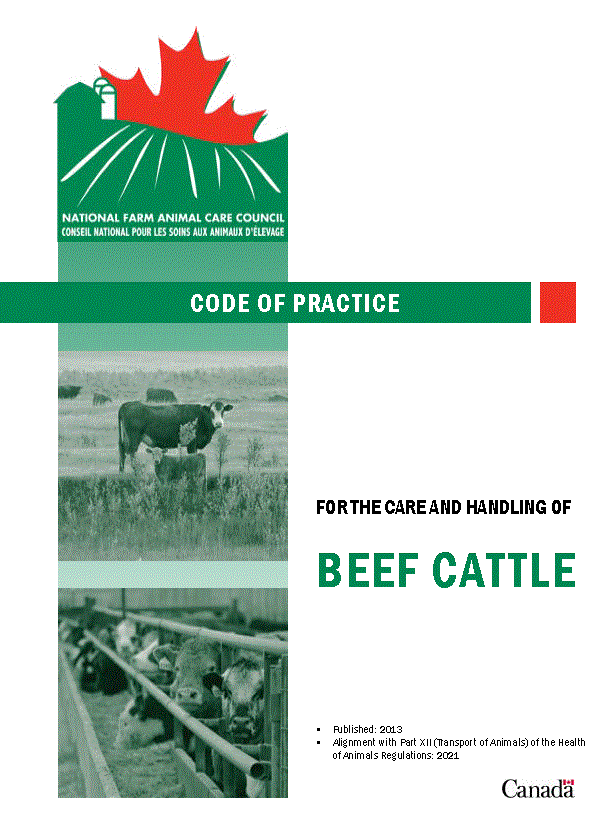Codes Of Practice
Developed through NFACC
- Bison
- Dairy Cattle
- Farmed Fox
- Farmed Mink
- Farmed Salmonids
- Goats
- Pullets and Laying Hens
- Rabbits
- Veal Cattle
Under Revision
Archived Recommended Codes of Practice
Code Development Process
Beef Cattle
CODE UNDER REVISION
The Code of Practice for the Care and Handling of Beef Cattle was released in 2013. The beef cattle Code’s 5-year review was completed in 2018, and the outcome of that review can be found here. An update to the beef cattle Code was initiated in 2023.
Code update timeline:
- Start: December 2023
- Public comment period: begins March 2nd, 2026
- Projected completion: first quarter of 2027
Timeline for all Codes of Practice being amended or updated.
Code update resources:
Current Code of Practice and related resources are below.
Committees
Code Committee members
The Code Committee is populated in accordance with Step 1 of NFACC’s Code development process.
| Role | Committee Member | Organization |
| Producer representative | Matt Bowman (Chair) | Canadian Cattle Association |
| Jack Chaffe | Canadian Cattle Association | |
| Melissa Atchison | Canadian Cattle Association | |
| Andrea van Iterson | Canadian Cattle Association | |
| Leigh Rosengren, DVM, PhD | Canadian Cattle Association | |
| Transporter | Trevor Currie | Canadian Livestock Transporters’ Alliance |
| Veterinarian | Mike Jelinski, DVM | Canadian Veterinary Medical Association |
| National animal welfare advocacy association | Stewart Bauck, DVM | World Animal Protection Canada |
| Provincial animal protection enforcement authority | Leanne Niblock | Alberta SPCA |
| Provincial government representative with responsibilities in animal welfare | Rachel Chiasson, MSc | Ministère de l'Agriculture, des Pêcheries et de l'Alimentation du Québec |
| Retail and food service organization | Adam Brown | Restaurants Canada |
| Processor | Calvin Vaags | Canadian Meat Council |
| Federal government | Angela Rouillard, PhD | Agriculture and Agri-Food Canada |
| Sarah Johannson, MSc | Canadian Food Inspection Agency | |
| Researcher/academic | Karen Schwartzkopf-Genswein, PhD | Scientific Committee Chair |
Scientific Committee members
The Scientific Committee is populated in accordance with Step 2 of NFACC’s Code development process.
| Name | Named by |
| Karen Schwartzkopf-Genswein, PhD (Chair) | Canadian Society of Animal Science |
| Diego Moya, DVM, PhD | Canadian Society of Animal Science |
| Karin Orsel DVM, PhD, DECBHM | Canadian Veterinary Medical Association |
| Claire Windeyer, DVM, DVSc | Canadian Veterinary Medical Association |
| Derek Haley, PhD | International Society for Applied Ethology |
| Ed Pajor, PhD | International Society for Applied Ethology |
- PDF version (1 MB)
- HTML version (or select from the Table of Contents below)
There are a limited number of hard copies of this Code. NFACC encourages use of the electronic version and does not store hard copies. If hard copies are required, please contact the Canadian Cattle Association.
Please note that content in the transportation section of this Code, along with additional transportation-related content (e.g., glossary terms) that had referenced or reflected the outdated version of Part XII (Transport of Animals) in the Health of Animal Regulations (HAR), or the now archived Compromised Animals Policy, has been updated to align with the amended regulations, which took effect on February 20, 2020. Hard copies of the Codes that were printed prior to this alignment will not include these updates. For clarity, Codes that have been updated will include a statement on the front cover that reads “Alignment with Part XII (Transport of Animals) of the Health of Animals Regulations: 2021”.
This update process was strictly aimed at revising existing text that no longer aligned with the amended HAR. Every effort was made to respect the original priorities and decisions of the Code Development Committee (e.g., text from the HAR was not added if it was not covered in the original Code). In case of a discrepancy between the hard copy and online version of a Code, the online version shall take precedence.
Other resources:
- Canadian Feedlot Animal Care Assessment Program
- Scientific Committee report - Review of scientific research on priority issues - November 2012
- Beef Cattle Code Q & A
- NFACC Code development process
Canadian Veterinary Medical Association (CVMA)
- Horn Management of Cattle - Position Statement
- Castration of Cattle, Sheep, and Goats - Position Statement
Table of Contents
| Preface | ||||
| Introduction | ||||
| Section 1 Animal Environment | ||||
| Section 2 Feed and Water | ||||
| Section 3 Animal Health | ||||
| Section 4 Animal Husbandry | ||||
| Section 5 Transportation | ||||
| Section 6 On-Farm Euthanasia | ||||
| References | ||||
| Glossary |
| Appendices | ||
| Appendix A | - Body Condition Scoring | |
| Appendix B | - Nutrient Requirement Guidelines for Beef Cows and Growing Beef Cattle | |
| Appendix C | - Calving: When and How to Help | |
| Appendix D | - Transport Decision Tree | |
| Appendix E | - Lameness Descriptions Rendering Animals Compromised or Unfit for Transport | |
| Appendix F | - Euthanasia - Secondary Kill Steps: Bleeding Out and Pithing | |
| Appendix G | - Resources for Further Information | |
| Appendix H | - Participants | |
| Appendix I | - Summary of Code Requirements | |

